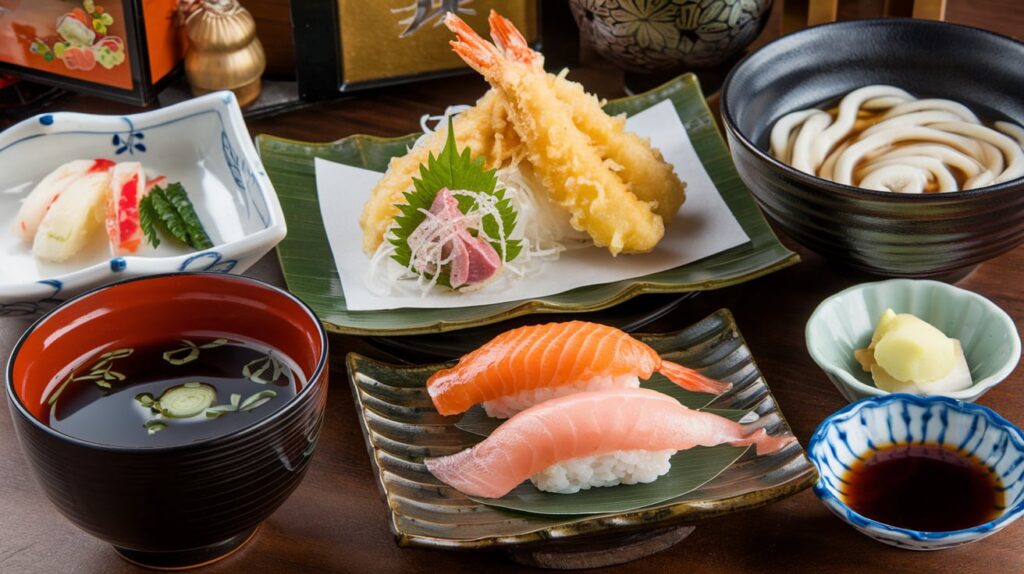Dive into the World of Authentic Japanese Cuisine: A Complete Guide
I’m excited to share my love for Japanese food with you. We’ll explore sushi, ramen, and sashimi together. Japanese food has changed over time, influenced by its makers and where it’s eaten.
It’s all about using ingredients that are in season and from the right place. Just like in a bento box or at an izakaya.
Japanese food has something for everyone, from tempura to miso’s many flavors. We’ll discover new things, like giant maguro and different noodles. Whether you love sushi or want to try okonomiyaki, this guide will show you Japanese food’s world.

Exploring Japanese cooking inspires me. It’s all about creativity and hard work, from simple onigiri to complex kaiseki meals. Japanese food is a true art form, with a rich history and many regional flavors.
Key Takeaways
- Japanese cuisine is a culinary art form that emphasizes seasonality and regionality of ingredients.
- Sushi, ramen, and sashimi are popular Japanese dishes that offer a unique experience for every palate.
- Respecting the seasonality and regionality of ingredients is crucial in Japanese cooking.
- Japanese cuisine offers a wide range of dishes, from simple onigiri to complex kaiseki meals.
- Tempura, miso, and udon noodles are just a few examples of the many delicious ingredients and dishes that make up Japanese cuisine.
- Visiting an izakaya or trying a traditional bento box can be a great way to experience Japanese cuisine.
Understanding Traditional Japanese Cuisine and Its Core Elements
Exploring Japanese cuisine, I see how much it values fresh, local ingredients. This is why miso soup and teppanyaki taste so good. They show the balance and harmony Japanese cooking aims for.
Matcha and seasonal ingredients add to the joy of Japanese meals. Whether it’s a big event or a quiet dinner, Japanese food has many choices. For instance, a quick recipe for sauteed mushrooms with soy butter sauce can spice up any weeknight.
Some top Japanese dishes include:
- Teppanyaki with sauteed mushrooms and soy butter sauce
- Miso soup with steamed veggies
- Easy dinner ideas like matcha-flavored chicken or salmon
Adding these elements to your cooking lets you make tasty Japanese dishes at home. Whether you want something simple or fancy, Japanese cuisine has it all.
Mastering Popular Japanese Dishes at Home
To make real Japanese dishes, you need to know about simple ingredients and cooking. A tasty side dish, like stir-fried veggies with garlic and ginger, takes just a few seconds. These simple things are key to Japanese food, and they make meals yummy and balanced.
If you don’t eat meat, you can still enjoy Japanese flavors. Just use vegetarian-friendly stuff and seasonings. The secret to a great Japanese dish is balancing five flavors: salty, sweet, sour, and umami. This way, you can make many dishes, like sushi and tempura, that taste amazing and are true to Japanese style.

Try making sushi, ramen, and tempura at home. They’re easy to make and great for a quick meal. Adding garlic, ginger, and umami flavor makes your dishes healthy and tasty. Whether you’re good at cooking or just starting, Japanese food is all about trying new things and making meals that feel right.
Here are some tips for a healthy and tasty Japanese meal:
- Use fresh, seasonal ingredients to create a balanced and harmonious meal
- Incorporate garlic and ginger into your cooking for added flavor
- Experiment with different seasonings, such as umami flavor, to create a variety of dishes
- Keep it simple by using simple ingredients and cooking techniques
Conclusion: Embracing the Art of Japanese Cooking
As we wrap up our look at real Japanese food, remember it’s more than just recipes. It’s about the spirit of Japanese cooking and caring for the seasons and places of food. Japanese cooking is a journey, not just a goal. It’s a lifelong learning path.
By diving into this, we can truly get the heart of Japanese cuisine. We can make our lives better with quick recipes, easy dinners, and finding umami flavors.
Whether you’re a pro chef or a home cook who loves to cook, Japanese cuisine has lots to share. You can learn to make vegetarian dishes or get better at traditional ways. Marisa, who loves sushi, says it teaches her discipline, patience, and respect. She also brings curiosity and creativity to it.
This shows what it means to love Japanese cooking. It’s about finding yourself, striving for the best, and celebrating a rich cultural tradition.
FAQ
What are the core elements of traditional Japanese cuisine?
Traditional Japanese food uses soy sauce, miso, rice, and fresh produce. It also includes cooking methods like sautéing and steaming. Seasonality and how food looks are very important too.
What are some popular Japanese dishes that can be mastered at home?
You can make sushi, ramen, tempura, and teppanyaki at home. Try making side dishes like stir-fried veggies or sautéed mushrooms with soy butter sauce. It’s a fun way to learn about Japanese food.
What is the importance of embracing the art of Japanese cooking?
Learning Japanese cooking can make your life and cooking better. It teaches patience and respect. It’s about using simple, quality ingredients to make tasty food.
What kind of traditional Japanese cooking equipment is used in the kitchen?
Traditional Japanese cooking tools include teppanyaki grills and sushi mats. You also need special knives and utensils for cutting. These tools help you make real Japanese dishes at home.
How has sushi evolved over time?
Sushi started as street food in the Edo era. Now, it’s a fancy experience called omakase. It still focuses on fresh ingredients and local traditions.
Disclaimer: This blog and all images are made by AI
Leave a Reply
You must be logged in to post a comment.